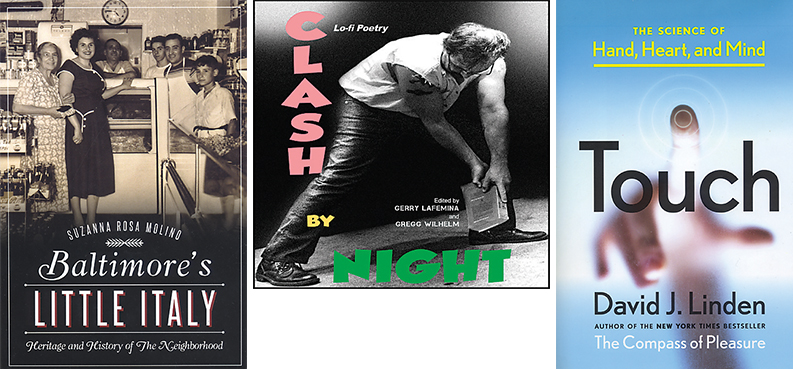Arts & Culture
Book Reviews: May 2015
The latest from Suzanna Rosa Molino, David J. Linden, and CityLit Press.
Baltimore’s Little Italy
Suzanna Rosa Molino (The History Press)
Decades ago, the blocks of row houses nestled between Eastern and Pratt streets felt like slices of the old country. Little Italy was home to generations of families, whose children’s voices bounced off the cobblestones. It was a place where organ grinders and nuns in long, black habits weren’t surprising sights. Molino chronicles the history of this enclave, settled in the 1800s by immigrants from Naples and Genoa. The Baltimore native, who is also the director of a promotion center for the neighborhood (and wife of former Oriole Ken Singleton), remembers visiting her aunt and uncle there, and harbors much love for the community. Her book is full of delights, from old photographs of neighborhood groceries to recipes for tiramisu and St. Leo the Great Roman Catholic Church’s famous ravioli. It will make you long for an era when grandmas chitchatted on stoops, guys had nicknames like “Mugs” and “Fookey,” and you didn’t have to go far to find someone who would invite you to dinner.
Clash by Night
Edited by Gerry LaFemina and Gregg Wilhelm (CityLit Press)
Emotions run strong in this poetry anthology—outrage, despair, infatuation, longing, to name a few. But how could they not? Each poem is based on The Clash’s 1979 album London Calling, a post-punk masterpiece of raw energy and intense creativity. You’ll remember its infamous cover, which shows bassist Paul Simonon slamming his Fender Precision bass on stage. Co-edited by Baltimore’s own Wilhelm, who founded CityLit Press, and poet, writer, and punk rocker, Gerry LaFemina, the anthology debuts May 2 at the 12th Annual CityLit Festival. Both Wilhem and LaFemina hope it will be the first of many such anthologies to pair poems and iconic albums. Some of the poems are literal, others abstract. While some focus on the album as a whole, most home in on one specific track, mimicking its cadence or lyrical structure or focusing on one detail or character. The poems describe the longing of youth, social or political displacement, or simply how the authors felt upon those first formative listens to punk-rock classics such as “Train in Vain” and “Spanish Bombs.” You can almost hear the buzz of the needle on the vinyl and feel the vibration of the speakers.
See our Q&A with writer Gregg Wilhelm.
Touch: The Science of Hand, Heart, and Mind
David J. Linden (Viking)
If asked to name the senses, we’re quick to tick off “sight” and “smell.” But oddly, Linden writes, “touch” isn’t the first one to come to most minds, though it has such an intrinsic connection to our emotions. And, he points out, it has quite a presence in everyday language. Think of phrases like, “He rubs me the wrong way,” or, “I didn’t mean to hurt your feelings.” Linden, professor of neuroscience at The Johns Hopkins University School of Medicine, sets out to explain how touch is critical to us as humans and how it impacts our lives, becoming, as he puts it, “a crucial form of social glue.” The book can get a little science-heavy as Linden analyzes the nervous system, the brain, and the skin as organisms. But he weaves the lecture-type material with attention-grabbing anecdotes—including one from his time as a juror on a rape case and another about a funny, if freaky, sexual encounter—that help connect the anatomical stuff to our day-to-day experiences.
